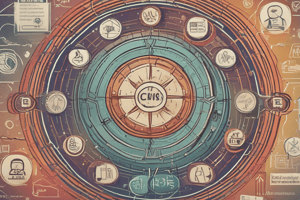Podcast
Questions and Answers
What is the primary reason for organizational change?
What is the primary reason for organizational change?
- To achieve a desired outcome (correct)
- To follow industry trends
- To improve employee morale
- To reduce costs
Structural change is a type of cultural change.
Structural change is a type of cultural change.
False (B)
What are the two main categories of stakeholders in organizational change?
What are the two main categories of stakeholders in organizational change?
Internal stakeholders (e.g. employees, management) and External stakeholders (e.g. customers, suppliers)
Stakeholder engagement involves identifying, analyzing, and responding to stakeholders' needs and _______________________.
Stakeholder engagement involves identifying, analyzing, and responding to stakeholders' needs and _______________________.
Which of the following is a strategy for stakeholder engagement?
Which of the following is a strategy for stakeholder engagement?
Rational resistance to change is based on emotional concerns.
Rational resistance to change is based on emotional concerns.
What are the three main reasons for resistance to change?
What are the three main reasons for resistance to change?
Managing resistance to change involves addressing concerns, building _______________________, and incentivizing change.
Managing resistance to change involves addressing concerns, building _______________________, and incentivizing change.
Match the following types of change with their descriptions:
Match the following types of change with their descriptions:
What is the primary goal of stakeholder engagement during organizational change?
What is the primary goal of stakeholder engagement during organizational change?
Study Notes
Organizational Change
- Definition: A planned transformation of an organization's processes, systems, or culture to achieve a desired outcome.
- Types of change:
- Structural change: changes to organizational design, roles, or responsibilities.
- Cultural change: changes to values, beliefs, or behaviors.
- Technological change: changes to systems, processes, or tools.
- Reasons for change:
- External factors: market shifts, competition, customer needs.
- Internal factors: inefficiencies, innovation, strategic alignment.
Stakeholder Engagement
- Definition: The process of identifying, analyzing, and responding to stakeholders' needs and expectations during organizational change.
- Stakeholder groups:
- Internal stakeholders: employees, management, unions.
- External stakeholders: customers, suppliers, partners, government.
- Engagement strategies:
- Communication: transparent, timely, and consistent information sharing.
- Participation: involving stakeholders in the change process through feedback and input.
- Involvement: empowering stakeholders to take ownership of change initiatives.
Resistance to Change
- Definition: The natural reaction to change, often driven by fear, uncertainty, or loss of control.
- Types of resistance:
- Rational resistance: based on logical concerns or disagreements.
- Emotional resistance: based on personal feelings or biases.
- Reasons for resistance:
- Lack of understanding: unclear reasons or benefits for change.
- Fear of the unknown: uncertainty about the impact of change.
- Loss of control: perceived threat to autonomy or job security.
- Managing resistance:
- Addressing concerns: openly addressing and resolving concerns.
- Building trust: establishing trust through transparent communication and involvement.
- Incentivizing change: offering rewards or recognition for embracing change.
Organizational Change
- Organizational change is a planned transformation to achieve a desired outcome, involving changes to processes, systems, or culture.
- There are three main types of change: structural, cultural, and technological.
- Structural change involves changes to organizational design, roles, or responsibilities.
- Cultural change involves changes to values, beliefs, or behaviors.
- Technological change involves changes to systems, processes, or tools.
Reasons for Change
- Change can be driven by external factors, such as market shifts, competition, or customer needs.
- Change can also be driven by internal factors, such as inefficiencies, innovation, or strategic alignment.
Stakeholder Engagement
- Stakeholder engagement involves identifying, analyzing, and responding to stakeholders' needs and expectations during organizational change.
- There are two main types of stakeholders: internal and external.
- Internal stakeholders include employees, management, and unions.
- External stakeholders include customers, suppliers, partners, and government.
- Effective engagement strategies include communication, participation, and involvement.
- Communication involves transparent, timely, and consistent information sharing.
- Participation involves involving stakeholders in the change process through feedback and input.
- Involvement involves empowering stakeholders to take ownership of change initiatives.
Resistance to Change
- Resistance to change is a natural reaction, often driven by fear, uncertainty, or loss of control.
- There are two main types of resistance: rational and emotional.
- Rational resistance is based on logical concerns or disagreements.
- Emotional resistance is based on personal feelings or biases.
- Reasons for resistance include lack of understanding, fear of the unknown, and loss of control.
- Managing resistance involves addressing concerns, building trust, and incentivizing change.
- Addressing concerns involves openly addressing and resolving concerns.
- Building trust involves establishing trust through transparent communication and involvement.
- Incentivizing change involves offering rewards or recognition for embracing change.
Studying That Suits You
Use AI to generate personalized quizzes and flashcards to suit your learning preferences.
Description
Test your understanding of organizational change, its types, and reasons, including structural, cultural, and technological changes, and external factors driving change.



